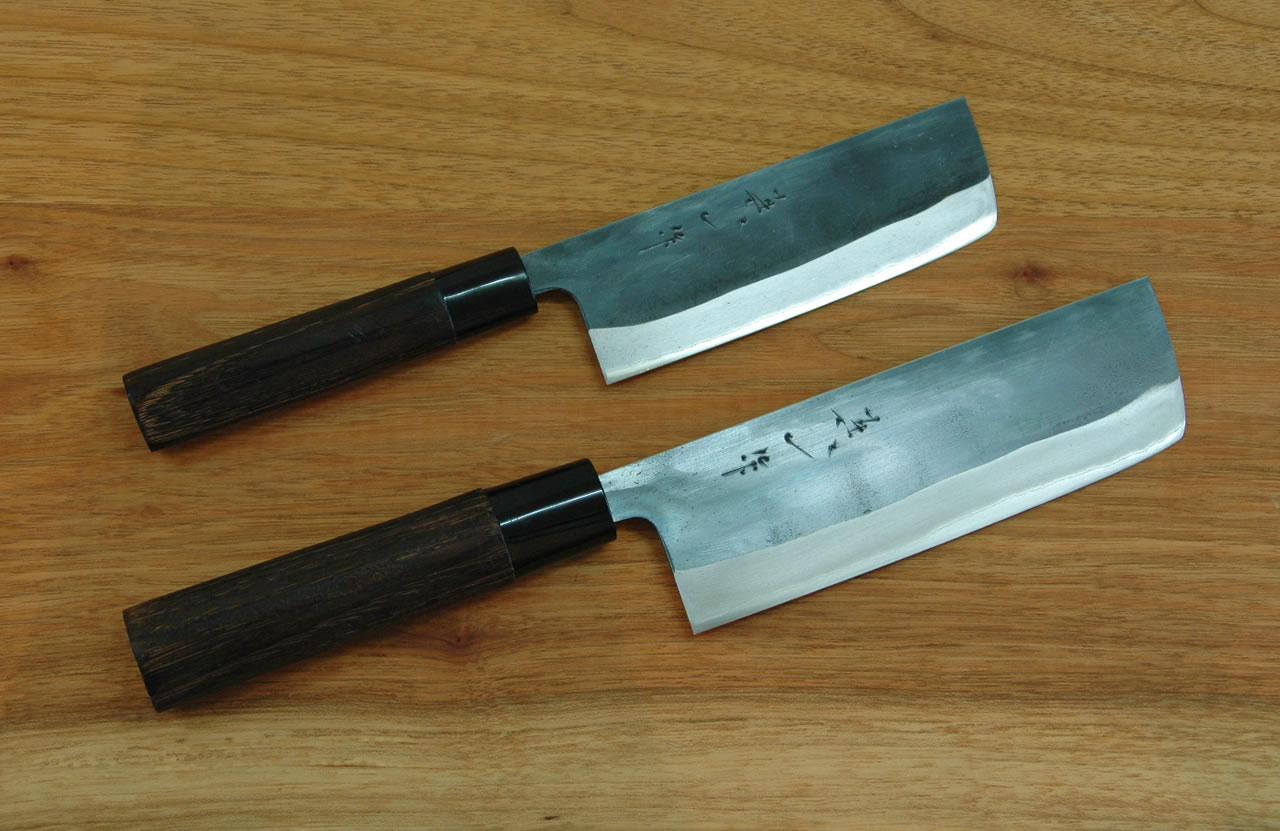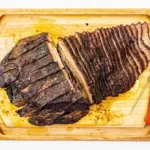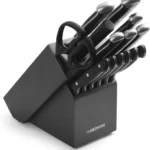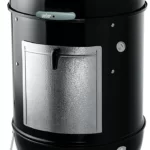When it comes to chopping veggies and rocking chives, there’s nothing quite like the best nakiri knife. Originally developed and used in Japan, this cutlery tool has become popular around the world due to its fast and delicate cutting tasks. We are talking about chopping onions, cutting fish meat and even chicken.
One of the main benefits of the Nakiri Trail is that you don’t have to work too hard to make the cuts. The design of the knife makes it much easier to get the job done without causing unnecessary hand fatigue.
Some of the unique characteristics of this type of knife are:
- Straight blade edge
- Square tip
- Slim and generally lightweight design
With these facts in mind, let’s take a look at some of the knife options available that will work best for you.
There are a lot of options to choose from when it comes to the best nakiri knife. While in general, all nakiri knives look roughly the same, not all knives work as expected. That is why we have compiled a list of the 7 best nakiri knives available today.
Best Nakiri Knife 2021 – Top 3 Picks

- VG-MAX core with 68 altering layers of stainless steel
- Beautiful Damascus pattern
- Solid edge-retention
- Comfortable pakkawood handle that’s also moisture resistan

- High-quality materials
- Stylish design
- Sharp
- Good blade width
- Ergonomic handle
- Full-tang construction
Best Nakiri Knife 2021 – Reviews
Nakiri Classic Shun 1.15 Inch Knife
As part of the classic line of Shun, the 6.5 – inch knife Nakiri offers surprising properties of other knives in the same line. Whatever your experience as a chef, it is designed to meet the needs of both amateur and professional chefs.
Let’s start by stating the obvious. Shun Classic knife Nakiri 6.5 inch is beautifully crafted and shows the extraordinary craft tradition of ancient Japanese sword making. Like most paring knives, this model has a wider blade.
The Nakiri Shun Classic 6.5 inch knife has a super VG-MAX steel core. VG-MAX is Shun’s proprietary steel, which means you can’t find another nakiri knife of the same quality. Why is it so special?
Due to the higher carbon content of steel, the 6.5-inch Nakiri Shun Classic Knife offers increased strength and durability. The added cobalt gives the blade better strength, while more chromium is responsible for better wear and corrosion resistance. Molybdenum further increases its corrosion resistance and strength. Vanadium is responsible for the impact resistance and cutting performance of the blade.
The VG-MAX core is coated with 34 layers of stainless steel on each side. They protect the inner core and ultimately help hold the edge longer. These layers create a beautiful damask pattern. The damask pattern not only gives the knife an attractive look but also prevents food from sticking to the blade. In addition, the corrosion resistance properties of the sheet are further improved.
This nakiri knife has a blunt tip and is perfect for chopping and mincing fruits and vegetables. Note that you should not shake the knife, as chef’s knives are usually shaken. It is made to be pushed through the products taken.
The Pakkawood ebony D-shaped handle looks like an extension of your arm. It is very resistant to humidity and therefore more durable than other handles.
Advantage
- VG-MAX core with 68 alternating layers of stainless steel
- Beautiful damask pattern
- Strong edge resistance
- Comfortable Pakkawood handle that also resists moisture
Disadvantage
- Expensive if not for sale
To read more of our articles, you can use our comparison between Shun and Miyabi or instructions for sharpening knives Shun read.
2. Nakiri 6 inch knife from the Dalstrong Shogun series
The 6-inch Nakiri knife from the Shogun Dalstrong series is another veggie killer that will serve you well for years to come. Our second runner-up looks elegant, but also powerful. Not only does it offer exceptional performance, but it also blends perfectly with your kitchen décor.
Made from super sharp AUS-10V steel with a Rockwell hardness of 62+, it meets and exceeds our high expectations. The blade core is extremely hard and durable and is protected by 66 layers of high carbon stainless steel. Due to the fact that it is high carbon steel, the blade is easy to sharpen and can hold its edge for a long period of time.
To increase toughness, the chopping blade is cryogenically cooled with liquid nitrogen. In this way, Dalstrong increases the crystalline structure of the steel and ultimately increases its strength, flexibility and toughness. Damascus lining is a statement of beauty, but it also protects the core from damage.
As a bonus, the blade has a hammered tsuchime finish that further enhances the striking appearance of the knife. Tsuchime finish reduces air resistance and prevents food from sticking to the blade.
The Shogun Dalstrong Series 6 Inch Nakiri Knife is hand finished and mirror polished. Using the three-step Honbazuke method, Dalstrong creates a surprisingly sharp cutting angle of 10 degrees per side. This is one of the sharpest knives we have been allowed to try and cuts vegetables and fruits with ease.
As for the handle, it is created with the same attention to detail as the blade. It is made from an incredibly strong material called G-10 Garolite and is built to last. The handle is very resistant to heat, cold and humidity. With comfort in mind, it is designed to fit like a glove while providing superior hand control and agility. Thanks to the full tang design, balance and breakage are not an issue.
Advantage
- High quality materials.
- Stylistic look
- Acute
- Good blade width
- Ergonomic handle
- Full tang construction
Disadvantage
- Expensive if not for sale
- Some users find it difficult
3. 7 inch Wusthof Classic Nakiri Knife
Our third competitor comes from Germany, produced by the exceptional brand Wusthof. This knife is designed for ease of use and offers precise cuts no matter the size or texture of the vegetables or fruits you have on hand. It’s so good that cutting paper-thin meat hasn’t failed either!
Like all other knives in the Classic range, the 7-inch Nakiri knife is made from special X50CrMo14 steel. Steel combines the perfect amount of chromium, moly, and vanadium, which is why knives made from it have certain properties.
For starters, the chrome content gives the classic 7-inch Nakiri knife the ability to repel dirt. Molybdenum, on the other hand, makes the blade extremely tough and resistant to corrosion. Finally, the vanadium further increases the hardness of the blade, making this knife as durable as possible.
Precision Edge Technology (PEtec) developed by Wusthof contributes to the overall performance of the knife. This nakiri knife is laser measured before sharpening and computers calculate the exact cutting angle of the blade. Then precision robots sharpen the blade on a whetstone and finally, it is polished with a special disc. With this technology, the Wusthof Classic 7 Inch Nakiri Knife is 20% sharper than other Nakiri knives and can maintain its 10 degree sharpness for a longer period of time.
Blade performance is enhanced by the hollow bottom construction. These indentations prevent ingredients from sticking to the blade. Certainly, the hollow bottom also makes the knife look better!
The triple riveted handle is made of polyoxymethylene, better known as POM. This synthetic material resists fading and fading and also feels natural in the hand. We assure you that the handle is extremely comfortable, but a little heavier than expected.
Advantage
- Excellent value
- High quality steel
- Precision edge technology ensures the sharpest edge with good edge resistance
- Comfortable grip
- Nice and functional hollow floor design
Disadvantage
- Better grip
If you are interested in our other reviews, check out the best Dalstrong knives and the best Wusthof knives .
4. 6-inch nakiri knives from the Kyoku Daimyo series
The 6-inch Nakiri Knife from the Kyoku Daimyo series is a joy to use and works as a knife for cutting vegetables and meats. This knife can accurately cut fresh produce as well as fish or chicken and will become our favorite. In addition to their unmatched performance, they are also a pleasure to watch.
The 6-inch Nakiri Kyoku Daimyo Knife’s cutting core is made of high-quality VG-10 steel. The VG-10 Super Steel is famous for its ability to hold an edge. In addition, it is very resistant. The cutting core is surrounded by 67 layers of Damascus stainless steel, further increasing the performance, edge retention, and durability of the knife.
Steel is cryogenically treated, a process used to treat steel at extremely low temperatures. In this way, the grain structure of the steel is improved, which ultimately leads to fewer imperfections. Thanks to this, the 6-inch Nakiri Kyoku Daimyo knife offers a more uniform sharpening and a better edge. Cryogenic treatment also improves wear and corrosion resistance while improving toughness and flexibility.
The kyoku nakiri knife in question is also sharpened using this method to ensure that the blade is as sharp as possible. Each side is handcrafted by skilled craftsmen with 8-12 degree mirror polish.
The riveted triple shank is in G10. The material undergoes a special treatment to offer resistance to heat, cold and humidity. It has excellent slip-resistant properties while providing a secure fit and comfort. The handle is beautiful too and is accented with a mosaic pin.
Advantage
- High quality 67 layer Damascus core.
- Sharp and easy to sharpen
- Strong, balanced and durable
- Comfortable
- G10 handle
- Nice design
Disadvantage
- Nothing
5.Shun Kanso Hollow Earth 6.5 Inch Nakiri Knife
In our Shun vs Miyabi comparison article, we already talked about another knife in the Kanso range: the 8-inch Shun Kanso chef’s knife. (Link to Shun vs Miyabi) Today we are testing the 6.5-inch Nakiri Shun Kanso knife.
Like all knives in the Kanso series, this Nakiri knife is made from the same highly refined AUS10A high carbon vanadium stainless steel. As you probably know, all the steels in the AUS series are prized for their strength, but the AUS10A is by far the strongest.
The AUS10A is very similar to the VG-10 steel that we discussed earlier in this article. However, compared to 440C steel, it has a lower chromium content, which means that it also has lower resistance to corrosion and wear. However, toughness, toughness and edge retention have been improved.
The traditional Kanso finish gives the knife a unique rustic look. It also hides scratches and scratches. Note that the Nakiri knife should not be shaken like the Kanso 8-inch chef’s knife. Since it is mainly used to prepare fruits and vegetables, a simple cut would suffice.
The 16 degree sharp blade has a durable edge. Although we have seen sharper knives, it has been shown to be accurate for preparing vegetables. Since it comes with a sunken bottom, it is incredibly slim. While a thinner edge also means the blade is a bit weaker, it will cut perfectly. The ground hollow cavities also help food to slide off the blade easily.
The handle is made from Tagayasan, a wood known in Japan as an “iron sword.” It is extremely durable, dense and a pleasure. The 6.5-inch Nakiri Shun Kanso knife has a full tang construction for better balance and durability. You can use a lot of force and leverage, and it won’t break under pressure.
Advantage
- High quality steel
- Heritage finish
- Hollow floor design
- Balanced, strong and durable
- Extremely comfortable wooden handle
Disadvantage
- A bit expensive
6.Yoshihiro VG-10 16 Layers Hammered 6.5 Inch Damascus Stainless Steel Nakiri Knife
The next knife on our list of the best Nakiri knives comes from the Yoshihiro family, whose first generation of knives dates back to the 20th century. Although Yoshihiro has been making knives for over 100 years, they were introduced to customers outside Japan in 2008. After reading a number of positive reviews from satisfied customers around the world, we ordered this Yoshihiro Nakiri knife.
It has a very attractive design and you can tell that it is covered in layers of Damascus just by looking at the knife. However, its core is VG-10 at 60 HRC, which exceeds the hardness of most other stainless steel cutlery. Due to this hardness, the cutting edge can be made thinner and sharper, allowing for easy cuts. VG-10 is also known for its strength and cutting ability and is one of the most durable steels on the market.
Above, there are 16 layers of Damascus steel that have been hammered into the core. This makes the blade look elegant, but protects the core and generally makes the knife stronger. It also eliminates friction and prevents food from sticking to the blade. The VG-10 core and the outer layers of Damascus are very resistant to dirt.
The Nakiri Yoshihiro VG-10 6.5-inch 16-ply Hammered Knife is completed by a beautifully crafted mahogany handle with three rivets. It extends to the full tang of the knife and is therefore highly unlikely to break under additional hand pressure. Thanks to the full tang construction, the knife is also more balanced and easier to control.
As this is a nakiri knife, it comes with a wider and flatter blade. A stainless steel pad has been added to prevent your fingers from sliding into the blade.
Advantage
- Nice design
- High quality VG-10 steel core, protected by 16 layers of softer Damascus steel
- Sharp and can hold an edge
- Strong and durable
- Very dirt repellent
- Full tang mahogany neck
Disadvantage
- Nothing
7. VG-10 Nakiri Bigsun 7 inch knife in 73 layer Damascus steel
Finally, we present you with a knife with a high quality knife design minus the high price. Although a nakiri knife was originally designed to prepare vegetables, it is often used to cut boneless meat. Don’t mistake it for a butcher knife because you really won’t be able to chop it with it.
Similar to the model mentioned above, this Nakiri knife from Bigsun has a VG-10 steel core. As explained above, this is extremely strong steel, which means that the blade is ultra-thin and therefore sharper. The core is protected by 73 layers of softer Damascus steel, hence the beautiful pattern you see on the blade. The outer layer not only looks smooth, it also prevents the knife from fading. In addition, it prevents friction and prevents food from sticking to the blade.
The wide, thin, flat edge blade is designed to make full contact with the cutting board for a complete cut. Sharpened from 15 to 18 degrees, the edge is sharp and handles all kinds of vegetables with the greatest of ease. However, we have found that the retention of the edges is not as good but otherwise indicated. Considering the price, we don’t mind sharpening it regularly.
This is another full tang nakiri knife that will provide enough control and balance for even the most inexperienced cooks. The handle is made of high quality acrylic resin and pakkaw wood and has a long service life. Offers superior control, agility and comfort.
Advantage
- Affordable
- High quality VG-10 steel core and 73 layers of Damascus steel
- Acute
- Strong and durable
- Well balanced and easy to control.
- Nice design
- Acrylic resin and pakka wood handle
Disadvantage
- Low edge retention
Things to Keep in Mind While Buying the Best Nakiri knife

To buy the best nakiri knife, you need to do a detailed research and identify the pros and cons of buying these knives. This way, you can choose a blade that offers the best performance, reliability, and durability. Some of the considerations to take into account are:
Blade material
The best nakiri knife should be made of high carbon steel with antioxidant and antioxidant properties to ensure its durability and longevity. Low carbon steel blades wear quickly and dull easily due to their smoothness. High carbon steel is easy to sharpen and remains sharp for a long time.
Price
The price of a knife is important and there should be no exceptions when it comes to paring knives. Have a budget that lets you know how much you can comfortably spend on a kitchen knife. The quality of the knives is more expensive than the inferior knives and this should be taken into account when considering the price of these knives.
Handle
One aspect that should not be overlooked when purchasing these blades is the handle of a nakiri knife. The high-quality handle provides great comfort and resistance when holding the knife in hand. Look for a curved grip, as these grips make a good grip that is also slip resistant, ensuring your safety.
Blade length
Blade length is another important consideration when looking for the best Japanese kitchen knife. The ideal blade should be at least 5 inches long to use a practical knife. Short blades can make tasks like chopping and cutting almost impossible.
Blade finish quality
It is necessary to evaluate the quality of the finish of the preferred sheet. This is because chunks of food tend to stick to poor-quality blades. In the hands, the high-quality blades ensure clean cuts and ensure that no pieces of food stick to the blade.
Advantages of using a Nakiri knife over other kitchen knives

Most chefs and cooks often wonder why they should buy a nakiri when they can still use a normal kitchen knife to cut vegetables. However, after learning how amazing and exciting it is to use a nakiri, you will hardly want to switch to another blade on your veggies.
The biggest advantage of this blade is that it has a blade-like design. The blade is flat at the tip and edge. This allows you to chop fruits and vegetables in a straight motion rather than a sawing or rocking motion like a normal kitchen knife. This ensures that you make clean, smooth cuts.
Another advantage of nakiri is that the pieces of food do not stick to the blade or edge. This is because the sharp, hollow blades ensure that the vegetable and fruit chunks come loose after the blade is cut. Regular blades, on the other hand, have strong blades, and as a result, chunks of vegetables and fruits are susceptible to getting stuck on the blade. This makes it difficult to get smooth, sharp cuts.
Nakiri knives are very light compared to most other blades used in the kitchen. This, in turn, makes it easier to control the blade during precise and precise cuts. In addition, they do not tire the hands and do not cause wrist fatigue. So you can use the blade to make tons of salads and vegetable strips.
Nakiri is also beautifully handcrafted and processed to achieve a look of exceptional beauty. As such, they will enhance the decor and look of your kitchen. They also have impressive edge retention, so there is no need to sharpen them after each use. Plus, most nakiri are easy to sharpen by hand, so you won’t incur professional blade sharpening costs.
Frequently Asked Questions about Best Nakiri Knife

Are Yoshihiro knives good?
Yes, the brand is definitely a trustworthy name to buy a new Nakiri knife.
Can I use it to replace my chef’s knife?
Unfortunately not.
They are different animals and you must use them for the purpose for which they are intended.
Can this type of advantage maintain your advantage over the long term?
No knife lasts forever.
You should always store it properly and use knife sharpeners to keep it sharp.
How do you use a nakiri knife?
When using a nakiri knife, you must follow a certain pattern. When using this blade, be sure to move it only up and down. You should not push or pull it in a horizontal motion. Keep a firm seat on the handle for precision and accuracy.
How to sharpen a nakiri knife?
There are many ways to sharpen a nakiri. However, the best ways to sharpen this blade are by hand with a sharp steel handle or a whetstone. You can also use an electric pencil sharpener specially designed for blades and nakiri.
Is a kitchen knife useful?
Nakiri blades are possibly one of the most useful knives in kitchens, especially for vegetarians. In fact, the blades allow you to carefully prepare vegetables and fruits by slicing, dicing, or chopping as desired.
Why are Japanese knives so expensive even with paring knives?
The main reason why the price of Japanese knives is usually much higher than other blades is the high build quality of Japanese knives. In addition, these blades use the best quality materials and have practical designs with great functionality.
Conclusion
Nakiri knives have enjoyed increasing popularity in recent times and many chefs these days cannot imagine their kitchens without them. In our opinion, the best nakiri knife doesn’t have to be expensive, as we often pay for the brand rather than the quality of the knife. However, this list includes what we think are the best nakiri knives available right now, and there is a knife to suit every budget.
Related Posts:
- Best Charcoal for Smoking 2021 – Reviews and Buyer’s Guide
- Best Kitchen Faucets of 2021 – Buyer’s Guide and Reviews
- Best Meat Grinder For Bones – Ultimate Guide and Reviews
- Best Nespresso Capsules of 2021: Best & Highest Rated!
- Best Cold Press Juicer Reviews – Top Picks & Guide
- Best Indoor Grills Reviews 2021













